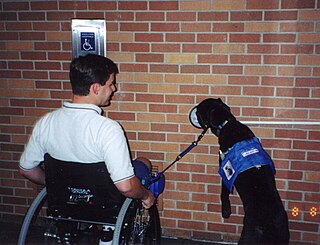North America
Canada
In Canada equality rights, as set out in provincial and federal anti-discrimination laws and in section 15 of the Canadian Charter of Rights and Freedoms, require that accommodation be made to various minorities. With a new addition being "family status" being included as well. (The origin of the term reasonable accommodation in Canadian law is found in its labour law jurisprudence, specifically Ontario (Human Rights Commission) v Simpsons-Sears Ltd , [1985] 2 SCR 536, and is argued to be the obligation of employers to change some general rules for certain employees, under the condition that this does not cause "undue hardship".) In Canada reasonable accommodation also means a legal and constitutional concept that requires Canadian public institutions to adapt to the religious and cultural practices of minorities as long as these practices do not violate the other rights and freedoms.
In Québec the Bouchard-Taylor Commission examined the subject of reasonable accommodation due to religious and cultural differences.
United States
In the United States, federal law requires that reasonable accommodations be made by providers of employment, education, or housing; and in courts and other public venues.
Education

Students are protected against discrimination on the basis of disability under US federal law. Different laws apply to younger students (before high school graduation) and to college students. Younger students are protected by the Individuals with Disabilities Education Act (IDEA) as well as other federal laws. [12] These students, who may be as young as three years old, may have an Individualized Education Program (IEP) or a 504 plan, both of which are essentially agreements between the students' families and their schools that state what the students' needs are and how those needs will be addressed at school. Younger students are entitled to more support from the school, including some medical and personal services, compared to students attending a college or university, who are entitled only to accommodations necessary due to a disability. [13] For example, a young child might be taught social skills in elementary school, or a teenager might be coached on organizational skills or time management, but after high school, students are not entitled to have schools provide these services. [13] After high school, IDEA no longer applies, and the Americans with Disabilities Act of 1990 becomes more relevant. [12]
In special education, a distinction is made between accommodation and modification. An accommodation provides the same educational work, but in a way that accommodates their disabilities. For example, a student with limited vision may be given a large-print book. [14] This student reads the same work of literature as everyone else in the class, but the student is able to see the words on the page because of the larger type. Similarly, a student with an episodic disability (one that occasionally flares up intensely for a brief time) may be allowed, if the student becomes ill just before a deadline, to turn in an assignment a few days late, just like a student who had gotten sick with a viral infection such as COVID-19 or influenza would normally be allowed to turn in an assignment shortly after recovering from the infection. [15] These students do the same work, just on a slightly different schedule. An unlimited exemption from turning in any assignment on time, on the other hand, is "would not be a reasonable accommodation". [13] At the university level, common accommodations include flexible deadlines, recording lectures, extra time on tests for slow readers, taking a test in a quiet room, and receiving a copy of lecture notes taken by another (frequently paid) student. [12]
A modification differs from accommodations by changing the curriculum, usually to make it easier for a student who is unable to complete the normal work. For example, if the class is reading one of Shakespeare's plays, then a student with an intellectual disability may be given a specially simplified, shortened version of the original play. [16] This allows the student to participate partially in the regular educational curriculum, but in a way that has been changed because of the student's individual limitations.
Employment
The Americans With Disabilities Act, known as ADA, was signed into law on 26 July 1990. It carried forward material from Section 504 of the Rehabilitation Act of 1973. A reasonable accommodation is defined by the US Department of Justice as "change or adjustment to a job or work environment that permits a qualified applicant or employee with a disability to participate in the job application process, to perform the essential functions of a job, or to enjoy benefits and privileges of employment equal to those enjoyed by employees without disabilities." [17]
State and local government services, programs, and activities
Title II of the ADA provides that "no qualified individual with a disability shall, by reason of such disability, be excluded from participation in or be denied the benefits of the services, programs, or activities of a public entity, or be subject to discrimination by any such entity". [18] State and local governments must provide reasonable accommodations to ensure such access, unless a fundamental alteration would result.
Public accommodations

Title III of the ADA requires private businesses open to the public and commercial facilities to provide reasonable accommodations to people with disabilities to ensure that they have equal access to goods and services.
Housing
Under Title VIII of the Civil Rights Act of 1968, as amended by the Fair Housing Amendments Act of 1988, codified in the United States Code at 42 USC §§ 3601–3619, and commonly known as the Fair Housing Act, virtually all housing providers must make reasonable accommodations in their rules, policies, practices, or services under certain circumstances. A reasonable accommodation must be granted when such an accommodation is necessary to afford a prospective or existing tenant with a disability an opportunity to use and enjoy a dwelling (including but not limited to apartments, single family homes, and other types of private and public housing) to the same extent as a person who does not have that disability. The Fair Housing Act covers "dwellings", and in many situations that term encompasses such non-traditional housing as homeless shelters and college dormitories. It bears noting that in regard to larger dwellings such as apartment buildings, the right to a reasonable accommodation under the Fair Housing Act requires that housing providers grant a requested reasonable accommodation that is necessary to enable a disabled tenant to enjoy an indoor or outdoor common area to the same extent as a non-disabled tenant enjoys such areas.







